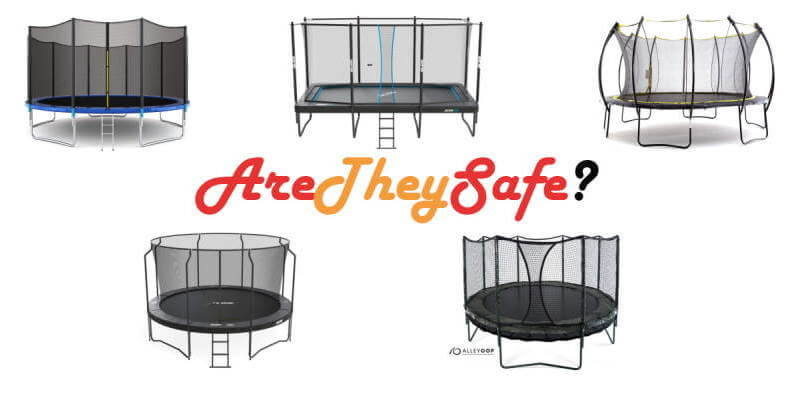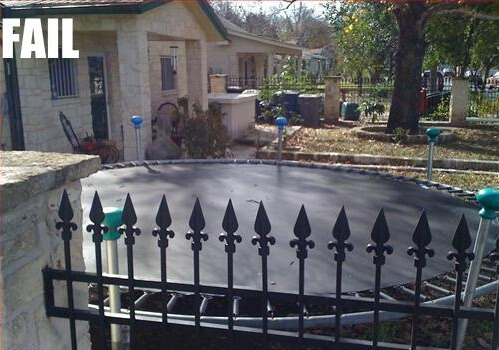Care About the Safety of Your Children?
Trampolines are safe for recreational use if proper adult supervision is present, and adherence to strict safety rules is maintained – this is the opinion of most trampoline manufacturers and supporters. The American Academy of Pediatrics (AAP) and other organizations such as the Consumer Product Safety Commission (CPSC) don`t think so…
According to them, trampolines, if not maintained properly, can provide a big safety risk for anyone using them, especially children while playing some trampoline games on the backyard trampoline.
NOTE: Just take a look at the trampoline safety instructions or manual which should also include advice for proper care and maintenance of the equipment.
Here is “Study Of Trampoline-Related Injuries” published in one of the issues of the journal Pediatrics:
- Younger children tended to have injuries to their arms and the majority of these were fractures or dislocations.
- Younger children also had a higher rate of facial injuries, most often lacerations.
- Older children most often injured their legs and these injuries tended to be bruises, sprains, strains and contusions.
- About 3 per cent of the injuries were serious enough for the children to be admitted to the hospital.
- Head and neck injuries accounted for 12 per cent of the injuries in younger children. In older children, the figure was 7 per cent
The US Consumer Product Safety Commission states that 95,000 hospital emergency room-treated injuries in 1998 were associated with trampolines. 75 were kids under the age of 15. Then in 2002, the CPSC again estimated that 60,000 trampoline-related emergency room-treated injuries were kids between the ages of 5 and 14. Since 1990, the CPSC has received six reported deaths involving the seemingly harmless trampoline. In data from 2009. there were nearly 98,000 U.S. trampoline injuries, 0.05 per cent of which, or about 50, causing paralysis or other permanent neurological damage, according to the National Electronic Injury Surveillance System.
If you make some precautions most of these accidents can be prevented. So inspect your trampoline regularly and have a safe fun!
Trampoline safety concerns & precautions Checklist:
We’ve divided it into two groups, before using a trampoline and while you’re jumping your fun out!
Before using a trampoline:
- Read the trampoline user manual – stick to safety guidelines.
- make sure hooks, springs and trampoline’s frame are properly padded
- always use a net enclosure, especially with small children, and make sure there are no holes.
- remove all objects from your pockets and the jumping area
- make sure the jumping area is dry and without tears & cuts.
While using a trampoline:
- always try to land in the center of the trampoline
- don`t talk and jump! you could bite on something you don’t want to bite. yelling YAAAY should be OK!
- don’t attempt to do back flips or somersaults
- never jump off a trampoline, always climb off – leave the first to the pros.
What about trampoline parks, are they safe enough? International Association of Trampoline Parks officials said they had spent several months on an ASTM International task group, helping create standards that give trampoline park owners “guidance for planning, operation and signage, while establishing clear, responsible-conduct guidelines for the public.”
According to the CPSC, most of the trampoline-associated injuries were sustained at private homes. The injuries and deaths were caused by:
- Colliding with another person while jumping on the trampoline.
- Landing improperly while jumping or doing stunts on the trampoline.
- Falling or jumping off the trampoline.
- Falling on the trampoline springs or frame.
The majority of injuries caused by using trampolines include sprains, fractures, scrapes, bruises and cuts, and serious injuries to the head and neck which can cause paralysis and death. According to the American Academy of Pediatrics (AAP), disastrous cervical spine injuries are rare, but head and neck injuries constitute a considerable number of the more serious injuries requiring hospitalization.
The CPSC also issued safety measures while using the trampoline which include:
- Somersaults should not be attempted because landing on the head or neck can cause paralysis.
- Trampolines should not be used without shock-absorbing pads that completely cover the springs, hooks, and frames.
- Trampolines should be laced away from structures, trees, and other play areas.
Safety guidelines issued by the AAP organization regarding trampoline safety:
- Steel frame and springs should be covered with a safety pad.
- Impact-absorbing safety surface material for impact areas
- Maintenance and repair for tears, rust, and detachments.
- Safety harnesses and spotting belts
- Setting the trampoline in a pit so the mat is at ground level should be considered (Read review of best inground trampoline available in Ireland)
- Ladders may provide unintended access to the trampoline by small children and should not be used.
- Only one person should use the trampoline at a time.
- In supervised settings, the user of the trampoline should be at the centre of the mat. The user of the trampoline should not attempt manoeuvres beyond capability or training, thereby putting them at risk for injury.
- Personnel trained in trampoline safety and competent spotters should be present whenever the trampoline is in use.
- Even in supervised training programs, the use of trampolines for children younger than 6 years of age should be prohibited.
- The trampoline must be secured and not accessible when not in use.
What parts of trampoline you should care about most?
Honestly, Everything is Important!
Trampoline springs are part of the trampoline which gets hit all the time. With rust or broken hooks, it can be real-time bomb. If any of the trampoline springs is broken, the weight it needed to support will be transferred to surrounding springs increasing the danger of their breakage. If you find springs like that please do not continue to use them until you replace a problematic part.
Trampoline mats are another thing to be careful about. Not only you are jumping on it all the time, but rain and UV rays can also do pretty much damage to it. If you`ll see a part which is torn or wear do not jump on it until the trampoline mat is replaced.
Trampoline Enclosure – preventing #1 injury on a trampoline – falling out of it! Always check if there are no cuts on the enclosure!
Taking routine inspections can save you a day. Those are the accidents that can be prevented but do happen only because of human mistakes. In this case, this is mostly laziness to do 30-second work.
If you need a new trampoline, feel free to check our Reviews of the best Irish trampolines


